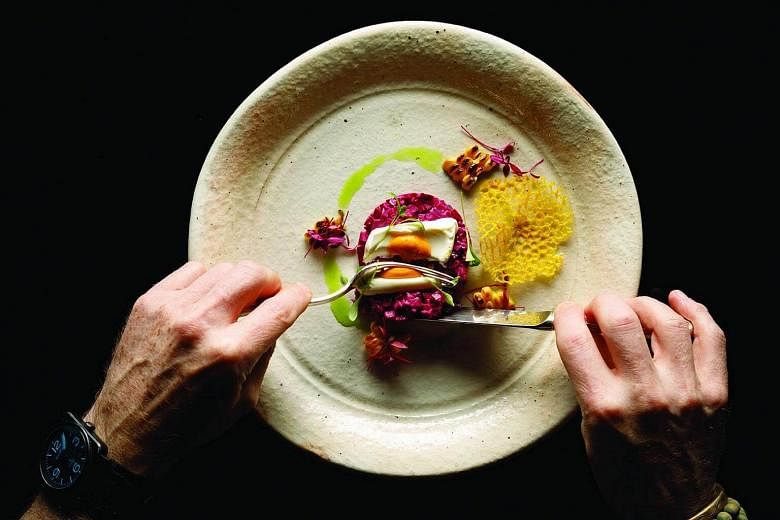(THE BUSINESS TIMES) - If you're a meat-eater who dreads dining out with vegetarians, it's because the only options you had were tofu or mock meat-related, salads or some variation of tomato pasta. If you're trying to be vegetarian yourself, the reasons for lapsing into omnivorism are for the same reasons above - sheer, utter boredom.
Not so now. The vegetarian movement that has swept major cities around the world from Los Angeles to Melbourne - the latter touted as the next vegan capital of the world with the sheer number of meat and egg-free dining options - is finally getting a toe-hold in Singapore. The obsession with wagyu may show no signs of abating, but the demand for healthier or lighter food is also growing at a steady clip, and chefs are taking on the challenge of creating vegetable dishes that are just as satisfying as their meaty counterparts.
At The Black Swan - part of the Lo & Behold group - its chophouse menu featuring steaks from boutique ranches is the main attraction but recently, one of its most Instagrammed dishes was its cauliflower steak by culinary director Daniel Sia. Grilled like a piece of meat, the pale brassica takes on a more pronounced flavour from the charring, and is jazzed up with puffed grains, black truffle shavings, maitake mushrooms and a slow-cooked egg.
Says Chef Sia: "Most of the time, vegetarians get some kind of asparagus pasta or whatever can be thrown together at the last minute. Or the kitchen just takes certain elements out of a normal dish and that's it. I don't want to just throw a salad on the menu. People go to restaurants to eat something that they can't make at home, otherwise why would they want to eat out?"
Besides, having well-thought-out meatless options on the menu benefits the restaurants too, he points out. "Having a properly-developed recipe helps the kitchen cope with such requests. We don't have to scramble to put something together on a busy night, and the customer gets a better overall experience."
On a wider scale, the group's managing partner Wee Teng Wen has noticed this demand growing at all of his outlets.
"Vegetarianism has definitely picked up in Singapore over the last couple of years," he says. "But you also have a lot more omnivores who are actively incorporating them in their diet," he says. "The rise of vegetables moving from the sidelines into the spotlight started picking up steam in fine-dining a couple of years ago and now we've seen it spread to casual and fast food establishments."
It's not just just his two-Michelin-starred restaurant Odette which has a full-vegetarian tasting menu. Besides The Black Swan, White Rabbit serves a Pumpkin Tarte as a main course option, while rooftop bar Loof offers vegetarian-friendly bar snacks like Twisties Charred Corn and a Kimcheeseburger.
Over at Bistro November on Keong Saik Road, Australian chef John-Paul Fiechtner changes his menu often based on whatever is fresh and available at the local markets. Whenever he comes up with a new tasting menu, he makes it a point for his menu to be at least 30 to 40 per cent vegetable-focused.
It's partly because vegetables have been a big part of his upbringing and relationship with food - coming from Australia - and that he also feels that vegetables are under-rated. He prefers to use them in their rawest form possible, shaving raw broccoli as a garnish for steak because it has similar characteristics as horseradish. He even makes dessert out of an entire raw pumpkin, seeds included.
"People do balk at a plate with raw broccoli but they are understanding once I explain why it's being used," says Chef Fiechtner. "When you cook them, you lose that natural flavour and goodness, so I do as little to them as possible."
Even chefs like Bjorn Shen, who is often associated with "dude food", is a big lover of leafy greens. His Middle Eastern-inspired restaurant Artichoke has a menu that's about 40 per cent vegetarian.
"I enjoy cooking vegetables more than cooking meat," he says. "When you shock and delight someone with vegetables, it's more meaningful than if you did it with meat, because no one expects that."
He adds, "People eat meat for the taste, so why can't people eat vegetables the same way? That's what chefs are trying to change. You can eat lamb for fun, or chicken for fun. So I believe you can also eat a romanesco or celery dish for fun."
For Justin Hammond, the fun about working with vegetables is in the challenge it brings. That's why his menu at Japanese-inspired small-plates restaurant Neon Pigeon is about one-third vegetable-centric, with examples such as celery tsukemono (pickles) and miso-roasted eggplant.
"With vegetables, you can get a lot of different sizes, shapes, and even textures. Like an eggplant might be different from one day to the next, and tomatoes are often either over-ripe or under-ripe," he explains.
That's where his instinct and technique come into play. "If you're grilling, for instance, you have to watch your heat control depending on whether they're older, younger or of different sizes. Meat you can get away with a bit, but vegetables are more delicate."
Belgian chef Emmanuel Stroobant has also had a lot of experience working with vegetables, and observes that heat can easily affect green vegetables (like spinach, kale, broccoli or snow peas), so even the temperature of the plate is a crucial factor.
"If you place a piece of bright green vegetable on a very hot plate, it turns flat or brown. With a piece of steak or fish you won't have any issue," points out the chef who became a vegetarian himself for health and personal reasons.
But eating vegetables is a mindset issue, Chef Stroobant believes. "As children, we are conditioned to believe that vegetables are not tasty, and this 'baggage' follows us into adulthood. A lot of people are eating vegetables out of guilt. But if the vegetables are well prepared, guilt turns to joy and the vegetable appreciation journey begins."
Sri Lankan-born Australian chef Rishi Naleendra admits that he was not the biggest vegetable-lover growing up. In fact it was only when he was exposed to well-executed vegetable dishes that he knew how good they could taste.
Yet it's not easy to get fresh, high quality vegetables in Singapore, which explains why his restaurant Cheek By Jowl's vegetable bill at the end of every month is as high as his meat orders. Nonetheless, Chef Naleendra still insists on featuring at least a strong vegetable component in every dish he creates, even those that highlight proteins, and so far hasn't seen many people leave their greens untouched.
"It was the wrong mindset from the start. As a kid, parents told you to eat your vegetables because they're healthy. It would've been different if they said to eat them because they're tasty. Vegetables are tasty - you just need to season and cook them properly."




